高二英语必修五语法知识点:倒装句讲解
- 格式:doc
- 大小:25.00 KB
- 文档页数:5
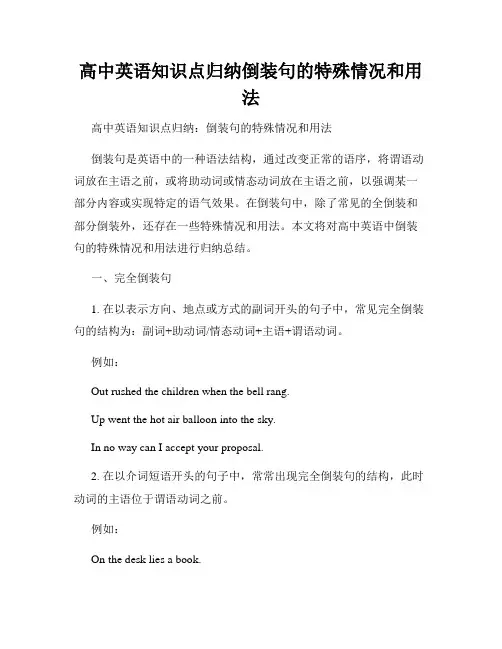
高中英语知识点归纳倒装句的特殊情况和用法高中英语知识点归纳:倒装句的特殊情况和用法倒装句是英语中的一种语法结构,通过改变正常的语序,将谓语动词放在主语之前,或将助动词或情态动词放在主语之前,以强调某一部分内容或实现特定的语气效果。
在倒装句中,除了常见的全倒装和部分倒装外,还存在一些特殊情况和用法。
本文将对高中英语中倒装句的特殊情况和用法进行归纳总结。
一、完全倒装句1. 在以表示方向、地点或方式的副词开头的句子中,常见完全倒装句的结构为:副词+助动词/情态动词+主语+谓语动词。
例如:Out rushed the children when the bell rang.Up went the hot air balloon into the sky.In no way can I accept your proposal.2. 在以介词短语开头的句子中,常常出现完全倒装句的结构,此时动词的主语位于谓语动词之前。
例如:On the desk lies a book.Under the bridge flows a river.二、强调句型倒装句常用于强调句型,通过改变正常语序,将被强调的部分提前至句首,以突出重要信息。
1. It is/was + 被强调部分 + that/who + 句子其余部分。
用于强调句子的主语、宾语、地点、时间等。
例如:It is Jane who won the singing competition.It was at the park where they met for the first time.It was yesterday that I finished reading the book.2. What/How + be 动词 + 主语 + 谓语动词 + 其他成分。
用于强调句子的母语、宾语、状语等。
例如:What I want is a peaceful world.How beautiful the sunset is!How hard he works!三、倒装句用于祝愿句和条件句1. May/Should + 主语 + 谓语动词.May you have a wonderful journey!Should you need any assistance, feel free to contact us.2. If + should/ were + 主语 + 谓语动词.If it should rain tomorrow, we will cancel the outdoor activity.If I were you, I would apologize to him.四、疑问句的倒装在一般疑问句中,主语和助动词/情态动词倒装。
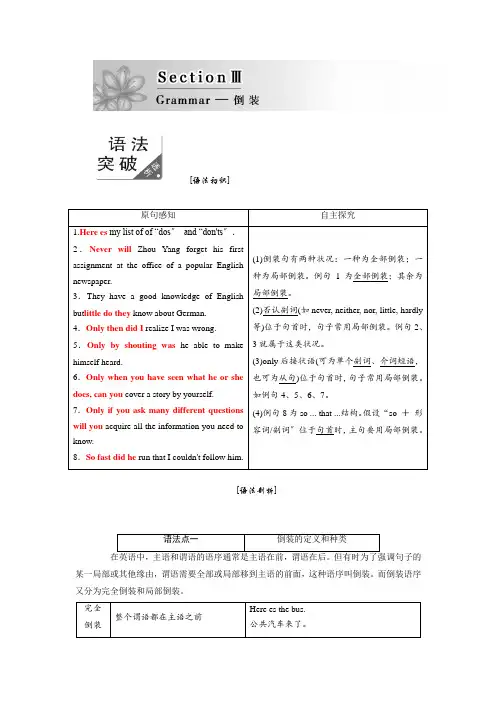
[语法初识]原句感知自主探究1.Here es my list of of “dos〞and “don'ts〞.2.Never will Zhou Yang forget his firstassignment at the office of a popular English newspaper.3.They have a good knowledge of English but little do they know about German. 4.Only then did I realize I was wrong. 5.Only by shouting was he able to make himself heard.6.Only when you have seen what he or she does, can you cover a story by yourself. 7.Only if you ask many different questions will you acquire all the information you need to know.8.So fast did he run that I couldn't follow him. (1)倒装句有两种状况:一种为全部倒装;一种为局部倒装。
例句1为全部倒装;其余为局部倒装。
(2)否认副词(如never, neither, nor, little, hardly 等)位于句首时,句子常用局部倒装。
例句2、3就属于这类状况。
(3)only后接状语(可为单个副词、介词短语,也可为从句)位于句首时,句子常用局部倒装。
如例句4、5、6、7。
(4)例句8为so ... that ...结构。
假设“so +形容词/副词〞位于句首时,主句要用局部倒装。
[语法剖析]语法点一倒装的定义和种类某一局部或其他缘由,谓语需要全部或局部移到主语的前面,这种语序叫倒装。
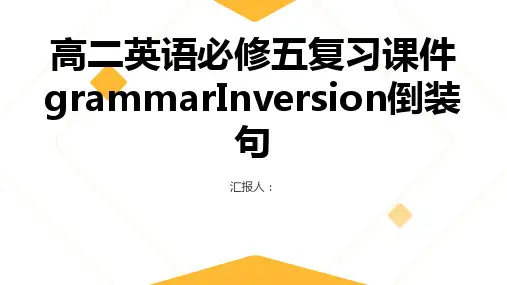


高二英语必修5 Unit 4 Making the news倒装讲解与练习语法专题--- 倒装巧记倒装〔一〕这〔里〕、那〔里〕、上、下、进、出、离。
〔二〕强调表语和状语。
〔三〕否认副、连位第一。
〔四〕so, nor, neither, 也如此。
〔五〕as(though), however引导让步句。
〔六〕only 修状位句首切牢记。
说明:〔一〕在以here, there 或out, in, up, down, away(off)等副词开头的句子里,表示强调,主语是名词时用倒装句。
此结构不需加助动词。
〔1〕Here comes the bus.〔2〕There goes the bell.〔3〕Down came the rain.〔4〕Into the hall came three women.〔5〕Away(off) went the girl without telling anyone.〔6〕Out rushed the man, gun in hand.〔7〕In came the teacher.如果后面的主语是人称代词时,如此主谓不倒装。
〔8〕Away she went with tears in her eyes.(二)为了保持句子的平蘅或为了强调表语和状语,或使上下文严密衔接,把它们放在句首用倒装句。
该结构不需加助动词。
〔1〕East of the town lies a beautiful lake.〔2〕In a lecture hall of a university in England sits a professor.〔3〕Outside the doctor’s clinic were twenty patients.(三)含有否认或半否认意义的副词、连词如:hardly(scarcely), never, not, not only, little, seldom, no sooner…(than), not until, no where等,放在句首时要用倒装句。
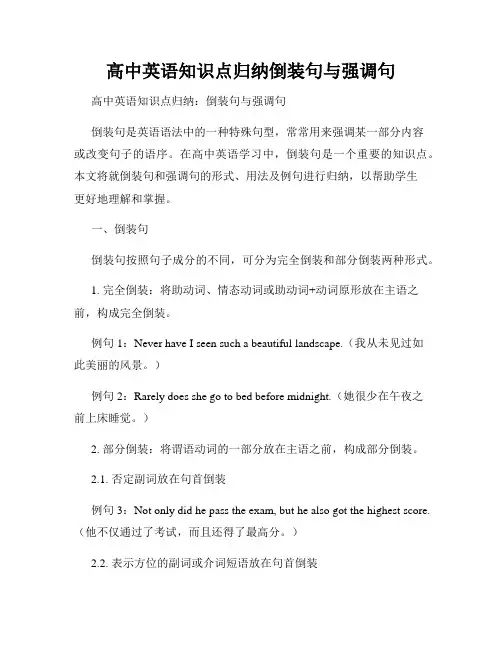
高中英语知识点归纳倒装句与强调句高中英语知识点归纳:倒装句与强调句倒装句是英语语法中的一种特殊句型,常常用来强调某一部分内容或改变句子的语序。
在高中英语学习中,倒装句是一个重要的知识点。
本文将就倒装句和强调句的形式、用法及例句进行归纳,以帮助学生更好地理解和掌握。
一、倒装句倒装句按照句子成分的不同,可分为完全倒装和部分倒装两种形式。
1. 完全倒装:将助动词、情态动词或助动词+动词原形放在主语之前,构成完全倒装。
例句1:Never have I seen such a beautiful landscape.(我从未见过如此美丽的风景。
)例句2:Rarely does she go to bed before midnight.(她很少在午夜之前上床睡觉。
)2. 部分倒装:将谓语动词的一部分放在主语之前,构成部分倒装。
2.1. 否定副词放在句首倒装例句3:Not only did he pass the exam, but he also got the highest score.(他不仅通过了考试,而且还得了最高分。
)2.2. 表示方位的副词或介词短语放在句首倒装例句4:Out rushed the students when the bell rang.(铃声一响,学生们就冲了出去。
)2.3. 在以“so/such+形容词/副词”作状语的句子中,将“so/such”放在句首倒装,强调后面的形容词/副词。
例句5:So beautiful is the sunset that everyone stops to admire it.(夕阳是如此美丽,以至于每个人都驻足欣赏。
)二、强调句强调句主要通过倒装句的形式,将要强调的成分放在句首,从而突出强调的重点。
1. 强调句的基本结构为“It is/was + 被强调成分 + that/who + 句子其他部分”。
例句6:It was John who broke the window.(是约翰打破了窗户。

倒装句用法归纳一.完全倒装定义:把谓语的全部放在主语之前。
完全倒装主要有以下两种情况。
(一)在以here, there, out, in ,up, down, away, back, off, now, then等副词开头的句子里,以示强调,要用完全倒装(其结构为:副词+谓语+主语)。
1.In came the teacher. 老师进来了。
2. Out rushed the boy.男孩冲了出去。
3. Down went the boy.男孩下来了。
;★主语是人称代词时,主语和谓语的语序不变。
1. In he came.2. Out she rushed.3. Down he went.(二为了保持句子平衡,或为了强调表语或状语,或使上下文紧密衔接时(其结构为:表语/状语+谓语+主语)。
1. Around his neck was a brown snake. 一条棕色的蛇缠绕着他的脖子。
2. On the ground lay an old sick goat. 一只生病的山羊躺在地上。
[与高考连接]]1. On the wall _______ two large portraits. (MET 85A. hangsB. hangC. hangedD. hanging2. Be quick! _______. (MET 86A. The bus comes hereB. The bus here comesC. Here the bus comesD. Here comes the busKey: 1. B 2. D二. 部分倒装定义: 把助动词、情态动词或系动词放在主语之前。
部分倒装主要有以下八种情况。
@(一)把副词so放在句首,表示前面所说的情况也适用于另一个人或物,其句型为:so+助/情/系+另一主语1. He is a ball fan. So am I.2. I have finished my paper. So has he.3. If he can do it, so can I.(二把neither/nor放在句首,表示前面否定的内容也适用于另一个人或物,其句型为:neither/nor+助/情/系+另一主语1. I have never been to Beijing. Neither/Nor has my sister.:2. Li Wei can’t answer the question. Neither/Nor can I.3. He isn’t willing to go, and neither/nor am I.(三 only所修饰的副词、介词短语或状语从句放在句首时1. Only then did I realize the importance of English. 直到那时我才意识到学英语的重要性.2. Only by this means can we work it out.只有通过这种方式我们才能解决它.3. Only when I have seen it with my own eyes will I believe it.只有当我亲眼看见的时候我才相信.★only修饰主语时,不倒装Only Wang Lin can answer my question.只有王林能够回答我的问题.@(四含有否定意义的副词、连词或介词短语放在句首时如:hardly, never, not, seldom, nowhere, little, not until, not only…but also, neither…nor…,no sooner …than…,hardly…when, at no time, by no means, in no time, in no way…A. 含有否定意义的副词1. Never shall I forget the day.我永远也不会忘记那一天。


高二英语必修五语法知识点:倒装句讲解高二英语必修五语法知识点第四讲、倒装句讲解。
倒装句是高考英语试卷中必定会考到的一个点,所以这个语法知识点不容忽视。
下面让为同学们详细的讲解关于倒装语句同时配有专项训练,看看你都能做对吗?1.倒装句的定义:英语中最基本的语序是主语先于谓语动词。
如果把谓语动词放在主语前面,就叫做倒装。
2.倒装句的构成a)完全倒装完全颠倒句子的主语和谓语被称为完全颠倒。
areyoufromhere?你是本地人吗?b)部分倒置只将助动词、系动词或情态动词移至主语之前,谓语的其他部分仍保留在主语的后面,称之为部分倒装。
例如:只有这样,我们才能做得更好。
只有这样我们才能把工作做得更好。
3.倒置的原因a)句子语法结构的需要。
例如:你参加会议了吗?你参加会议了吗?longlivepeace!和平万岁!b)某些句型的固定用法。
例如:suchwerehislastwords.他最后的话就是这样。
c)强调需要。
倒装句后,句子更加流畅生动。
例如:neverbeforehaveweseensuchasight.以前我们从来没有见过这样的情景。
在我们遇到困难之前。
我们面前有许多困难。
oftendidwewarnthemnottodoso.我们曾多次警告他们不要这样做。
4.倒装句的基本用法a)构成疑问句(除对主语或主语之定语提问的特殊疑问句外):我们什么时候去追求幸福?我们什么时候喝你的结婚酒?haveyouseenthefilm?你看了那部电影吗?b)在以副词开头的句子中,如here、there、now、then、In、away、updown等:awaywentthecrowdonebyone.人们一个一个地离去。
c)当副词+状语置于句首时:onlythendidherealizehismistakes.只有在那时他才认识到自己的错误。
只有这样,你才能学习数学。
只有这样你才能学好数学。
d)含有否定意义的副词或连词(如little,hardly,never,rarely,nosooner?than等)放在句首时:我没想到他还能活着回来。
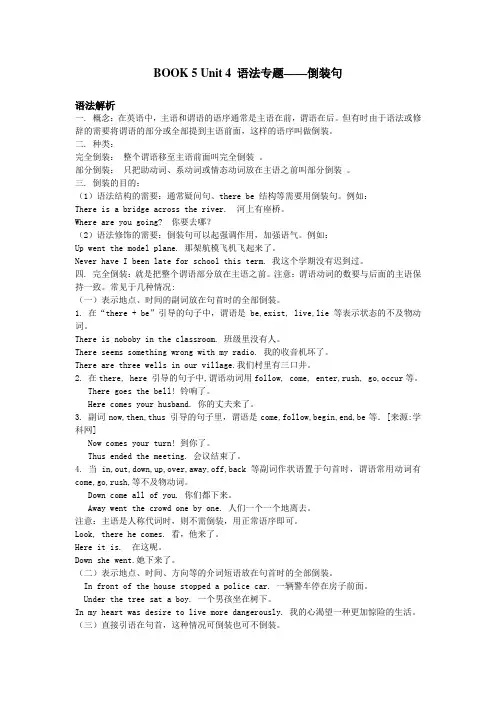
BOOK 5 Unit 4 语法专题——倒装句语法解析一. 概念:在英语中,主语和谓语的语序通常是主语在前,谓语在后。
但有时由于语法或修辞的需要将谓语的部分或全部提到主语前面,这样的语序叫做倒装。
二. 种类:完全倒装:整个谓语移至主语前面叫完全倒装。
部分倒装:只把助动词、系动词或情态动词放在主语之前叫部分倒装。
三. 倒装的目的:(1)语法结构的需要:通常疑问句、there be 结构等需要用倒装句。
例如:There is a bridge across the river. 河上有座桥。
Where are you going? 你要去哪?(2)语法修饰的需要:倒装句可以起强调作用,加强语气。
例如:Up went the model plane. 那架航模飞机飞起来了。
Never have I been late for school this term. 我这个学期没有迟到过。
四. 完全倒装:就是把整个谓语部分放在主语之前。
注意:谓语动词的数要与后面的主语保持一致。
常见于几种情况:(一)表示地点、时间的副词放在句首时的全部倒装。
1. 在“there + be”引导的句子中,谓语是be,exist, live,lie 等表示状态的不及物动词。
There is noboby in the classroom. 班级里没有人。
There seems something wrong with my radio. 我的收音机坏了。
There are three wells in our village.我们村里有三口井。
2. 在there, here 引导的句子中,谓语动词用follow, come, enter,rush, go,occur等。
There goes the bell! 铃响了。
Here comes your husband. 你的丈夫来了。
3. 副词now,then,thus 引导的句子里,谓语是come,follow,begin,end,be等.[来源:学科网]Now comes your turn! 到你了。
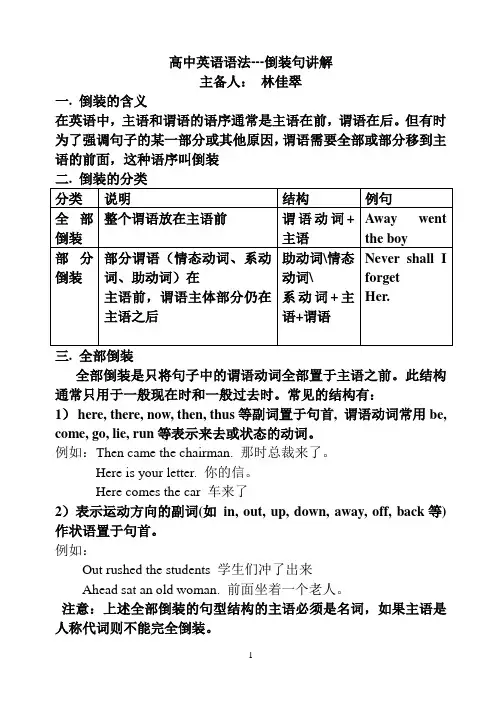
高中英语语法---倒装句讲解主备人:林佳翠一. 倒装的含义在英语中,主语和谓语的语序通常是主语在前,谓语在后。
但有时为了强调句子的某一部分或其他原因,谓语需要全部或部分移到主语的前面,这种语序叫倒装三. 全部倒装全部倒装是只将句子中的谓语动词全部置于主语之前。
此结构通常只用于一般现在时和一般过去时。
常见的结构有:1)here, there, now, then, thus等副词置于句首, 谓语动词常用be, come, go, lie, run等表示来去或状态的动词。
例如:Then came the chairman. 那时总裁来了。
Here is your letter. 你的信。
Here comes the car 车来了2)表示运动方向的副词(如in, out, up, down, away, off, back等)作状语置于句首。
例如:Out rushed the students 学生们冲了出来Ahead sat an old woman. 前面坐着一个老人。
注意:上述全部倒装的句型结构的主语必须是名词,如果主语是人称代词则不能完全倒装。
例如:Here he comes. 他来了。
Away they went. 他们走开了。
3)表示地点的介词短语置于句首或强调地点概念时,此时主句的动词常为be, sit, live, lie, stand, rise, go, come 等。
例如:Between the two buildings stands a tall tree.On the ground lay a sick goat.4) 为强调表语,把表语置于句首时,或为保持句子平衡时。
例如:Gone are the days when women were looked down upon. Present at the meeting was Mr Liu, who taught us English.5) 表示祝愿的句子。
高中英语知识点归纳倒装句的用法及常见情况倒装句是英语语法中一个重要的句法结构,它在句子中有特殊的应用。
本文将归纳总结高中英语中关于倒装句的用法及常见情况,以帮助大家更好地理解和运用倒装句。
一、倒装句的基本用法倒装句是指把原本主语和谓语的次序颠倒,使谓语动词或助动词出现在主语之前的一种句法结构。
在英语中,倒装句主要有三种基本形式:全部倒装、部分倒装和助动词倒装。
1. 全部倒装全部倒装是指将整个谓语部分完全颠倒,即将谓语动词或助动词放在主语之前。
常见情况有:在以否定词开头的句子中,当否定副词not,never,hardly,scarcely,little等放在句首时;以及在表示地点、时间或方式的状语从句中。
例1:Not only does he speak English fluently, but he also speaks French.例2:Hardly had I arrived home when it started to rain.例3:In the garden were some beautiful flowers.2. 部分倒装部分倒装是指将助动词,或情态动词,或谓语动词的某些形式移到主语之前。
常见情况包括:带有否定意义的词或短语出现在句首时;含有表示条件的副词或介词短语的句子;以及为了强调某一部分内容。
例4:Never have I seen such a beautiful sunset.例5:Had I known the truth, I would not have told her.例6:Only in this way can we achieve success in our study.3. 助动词倒装助动词倒装是指将助动词提到主语之前,用于疑问句或以so/neither/nor开头的句子,其目的是避免重复。
例7:Do you know him? —— No, I don't.例8:She is reading a book, and so am I.例9:He doesn't like ice cream, and neither do I.二、倒装句的常见情况除了基本的倒装句形式外,倒装句还有一些常见的情况和特殊用法需要掌握。
高中倒装用法教师辅导讲义知识图谱部分倒装句知识精讲部分倒装即只把谓语的一部分(如助动词、情态动词等)放到主语前,或把句子的强调成分提前。
使用部分倒装的情况包括:一、only+副词,介词短语或状语从句提前1. only修饰的状语(副词、介词短语或状语从句)位于句首时。
例句:Only after three operations was he able to walk without sticks.做过三次手术之后,他才能不用拐杖行走。
Only with more practice can you pass the driving test.只有多练习你才能通过驾驶考试。
2. as, though 引导的倒装句as / though引导的让步从句必须将表语或状语提前(形容词,副词,分词,实义动词提前)。
例句:Try hard as he will, he never seems able to do the work satisfactorily.不论他怎么努力,他好像都不能对自己的工作感到满意。
二、否定词提前1. 含有否定意义的副词(never, seldom, little, few, not, nowhere等)位于句首时。
例句:Seldom in all my life have l met such a brave man.我一生很少见过这么勇敢的人。
Never did she care about her own safety, though she was in great danger herself.虽然她处于极大的危险之中,但她根本不顾自己的安全。
2. not until位于句首时。
例句:Not until the early years of the 19th century did man know what heat is.直到19世纪初,人们才知道热是何物。
3.在no sooner...than..., hardly/scarccly/barely...when...结构中,前面部分位于句首时,其后的分句要部分倒装(谓语用过去完成时)。
InversionShe is a kind person 英语句子的语序英语句子的自然语序:英语句子的倒装结构:主语在前,谓语动词在后谓语动词放在主语之前自然语序Is she a kind person? 倒装语序倒装语序分为“全部倒装”和“部分倒装”。
在全部倒装的句子中,整个谓语都放在主语的前面;在部分倒装的句子中,只是谓语中的一部分(如助动词、情态动词或系动词be等)放在主语前面,其余部分仍放在主语后面。
下面将常见的全部倒装情况分述如下:1、here, there, now, then, thus等副词置于句首, 谓语动词常用be, come, go, lie, run等表示来去或状态的动词。
例如:There comes the bus!Now comes your turn.2. 表示运动方向的副词或地点状语置于句首,谓语表示运动的动词。
例如:Out rushed a missile from under the bomber. 轰炸机肚底下窜出一枚导弹。
Ahead sat an old woman. 前面坐着一个老妪。
3. 在there be或者there live(stand, appear, seem, remain, exist….) 句型中。
例如:There are thousands of people on the square.There lived an old fisherman in the village.There stands a little girl.4.在某些表示祝愿的句型中。
例如:Long live the People's Republic of China! 中华人民共和国万岁!May you all be happy. 愿你们都快乐。
5.某些表语位于句首,保持句子平衡,以强调表语. 句式:表语+系动词+主语(必须是名词) 1)表语为介词短语Among the goods are Christmas trees, flowers, candle s and toys. 2)表语为形容词 Present at the meeting were Mr White and many oth er guests. 3)表语为过去分词 Seated on the ground are a group of young people. 4)表语为进行时态中的现在分词 Lying on the floor was a boy. Standing beside the desk was a teacher.5)Such 作表语Such was Albert Einstein, a simple man of great achievements.Such is life.注意:上述全部倒装的句型结构的主语必须是名词,如果主语是人称代词则不能完全倒装。
高二英语必修五语法知识点:倒装句讲解高二英语必修五语法知识点第四讲、倒装句讲解。
倒装句是高考英语试卷中必定会考到的一个点,所以这个语法知识点不容忽视。
下面让为同学们详细的讲解关于倒装语句同时配有专项训练,看看你都能做对吗?1.倒装句的定义:英语最基本的词序是主语在谓语动词的前面。
如果把谓语动词放在主语前面,就叫做倒装。
2. 倒装句的构成a) 完全倒装将句子的主语和谓语完全颠倒过来,称之为完全倒装。
Are you from here? 你是本地人吗?Now comes the chance. 机会来了。
b) 部分倒装只将助动词、系动词或情态动词移至主语之前,谓语的其他部分仍保留在主语的后面,称之为部分倒装。
例如:Has he come? 他来了吗?Seldom have we felt as comfortable as here. 我们难得像在这里这么舒服。
Only in this way can we do the work better.只有这样我们才能把工作做得更好。
3. 倒装的原因a) 句子语法结构的需要。
例如:Did you attend the meeting? 你参加会议了吗?Long live peace! 和平万岁!b) 一些句型的固定用法。
例如:Such were his last words. 他最后的话就是这样。
c)强调的需要。
倒装以后,句子更加流畅生动。
例如:Never before have we seen such a sight. 以前我们从来没有见过这样的情景。
Before us lay a lot of difficulties. 在我们前面有很多困难。
Often did we warn them not to do so. 我们曾多次警告他们不要这样做。
4. 倒装句的基本用法a) 构成疑问句(除对主语或主语之定语提问的特殊疑问句外):When are we going to drink to your happiness? 我们什么时候喝你们的喜酒?Have you seen the film? 你看了那部电影吗?b) 在以here, there, now, then, in, away, up down等副词开头的句子中:Away went the crowd one by one. 人们一个一个地离去。
Here comes our teacher! 我们的老师来了!c) 副词only+状语放在句首时:Only then did he realize his mistakes . 只有在那时他才认识到自己的错误。
Only in this way can you learn maths well . 只有用这种方法你才能学好数学。
d) 含有否定意义的副词或连词(如little, hardly, never, rarely, no sooner…than 等)放在句首时:Little did I think that he could be back alive. 我没有想到他竟能活着回来。
Not until New Year’s Day shall I give you a gift. 我要到元旦那天才能给你礼物。
Hardly had the train arrived at the station when we ran towards the sleeping car looking for our guests.火车刚一进站,我们就跑到卧车那儿去找我们的客人。
e) 副词so或 neither(nor)在句首:He is interested in pop-songs, and so am I.他对流行歌曲感兴趣,我也如此。
He hasn’t been to the countryside, neither does he want to go there.他没有去过农村,他也不想去那里。
f) 在方式状语thus开头的句子中及程度状语so放句首:Thus ended his life. 这样结束了他的生命。
So loudly did he speak that even people in the next room could hear him . 他讲话的声音那样大,连隔壁屋子里的人都听得见。
2. so作“也”讲时,引导的句子用倒装语序,例如:He went to the film last night. So did I. 他昨天晚上去看电影了,我也去了。
如不作“也”讲而只起连词作用,表示一种结果的意思,句子就要用正常语序。
例如:His mother told him to go to the film. So he did. 他母亲叫他去看电影,他就去了。
“He is a tall thin man.”“So he is.”“他又高又瘦。
”“确实如此。
”3. 某些让步状语从句往往把表语提到主语前面或放在句首,以构成倒装结构。
例如:No matter how interesting the book is,he doesn't like to read it.不管这本书多有趣,他都不想看。
However hard a solid may be,we can change its shape. 不管一个固体有多硬,我们都可以改变其形状。
Young as he is, he knows a lot. 虽然他年轻,却知道很多东西。
4. 在虚拟语气中,如果非真实条件句省略if,须将主句中的were, had和should等助动词和主语颠倒形成部分倒装。
例如:Were he younger (= If he were younger), he would learn skating. 假如他年轻一些,他就会去学溜冰。
Should they forget (= If they should forget) to bring a map with them, they would get lost in the woods如果他们忘记带一张地图的话,他们就会在深林里迷路。
Had they realized (= If they had realized) how important the task was, they wouldn’t have refused toaccept it. 假如他们认识到这个任务是多么重要的话,他们就不致于拒绝接受这项任务。
单项选择1. My brother had a cold last week, _________.A. so had IB. so did IC. I had soD. so I had2. Not until _________ home __________ his parents had been ill for three days.A. he got; he knewB. did he get; he knewC. he got; did he knowD. did he get; did he know3. In hardly any situation ________ find her sad.A. that you canB. that can youC. you canD. can you4. Be quick! _________.A. The bus comes hereB. Here comes the busC. The bus here comesD. Here is the bus coming5. In ________ and the lesson began.A. the teacher cameB. the teacher comingC. came the teacherD. did the teacher come6. On the wall _________ two large portraits.A. hangsB. hangC. hangedD. hanging7. --- Do you know Jim quarreled with his brother?--- I don’t know, _________.A. nor don’t I careB. nor do I careC. I don’t care neitherD. neither don’t I care8. Only when _________ how important it is to master English.A. did I work I realizedB. I worked did I realizeC. did I work did I realizeD. I worked I realized9. _______ in the darkness that he did not dare to move an inch.A. So frightened he wasB. So frightened was heC. He was frightened soD. So he was frightened10. _______, she is still as strong as you.A as old she is B. Old as she isC. As she is oldD. As old is she。